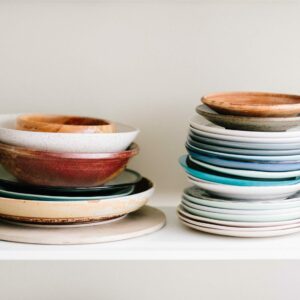The JavaScript Array has everything to acts as a nice Stack structure, the only thing is missing is a peek() method. In this blog I'll discuss two ways of implementing a stack based on the array.
What's a stack?
A picture says more than words:

Let's start with defining the what a stack should look like and let's keep it as close to what the Array already gives us:
interface Stack<T> {
push(item: T): number
pop(): T | undefined
peek(): T | undefined
readonly length: number
[Symbol.iterator](): Iterator<T>
}
Note: I've included the iterator to support spreading without having to cast.
Module augmentation
The push, pop, length and iterator are already present on the Array object. The only thing we miss is the peek object. Let's use TypeScript module augmentation to add the peek feature to the array:
//!file: m-stack.ts
export interface Stack<T> {
push(item: T): number
pop(): T | undefined
peek(): T | undefined
readonly length: number
[Symbol.iterator](): Iterator<T>
}
declare global {
interface Array<T> {
peek(): T
}
}
if (!Array.prototype.peek) {
Array.prototype.peek = function <T>(): T {
return this.length == 0
? undefined
: this[this.length - 1]
}
}
You can use it like this:
import { Stack } from "./m-stack"
import "./m-stack"
let stack: Stack<string> = []
stack.push("kaas")
stack.push("is", "heel")
stack.push("lekker")
console.log(stack.length, stack.peek());
stack.pop()
console.log(stack.length, stack.peek());When we forget import "./m-stack", we'll get a runtime error: TypeError: stack.peek is not a function! Took me some time to figure out why.
Pro:
- I like the fact that we can declare an array and just cast it to
Stack<T>and work with it.
Con:
- I really don't like the way we need to wire this up: it looks like we're importing the same thing twice.
- It extends the prototype, a technique some would call: prototype pollution. It looks like Node.js make this type of pollution more scoped.
A class wrapper
If we don't want to pollute the array, we could create our own Stack class based on the Array:
//!file: n-stack.ts
export class Stack<T> {
private items: T[]
constructor(iterable: Iterable<T> = []) {
this.items = [...iterable]
}
pop = () => this.items.pop()
push = (...items: T[]) => this.items.push(...items)
peek = () =>
this.length == 0
? undefined
: this.items[this.length - 1]
get length() {
return this.items.length
}
*[Symbol.iterator]() {
for (let item of this.items) yield item
}
}
Usage is similar:
import { Stack } from "./n-stack"
let stack = new Stack<string>()
stack.push("kaas")
stack.push("is", "heel")
stack.push("lekker")
console.log(stack.length, stack.peek());
stack.pop()
console.log(stack.length, stack.peek());
console.log([...stack])Pro:
- It uses the same API as the
Arrayobject so it should feel familiar. - It does not suffer from prototype pollution.
Con:
- Each stack is instantiated as a new object.
- We need to use the the iterator to get our objects back.
Bonus: Queue
If you want a queue in the same way, just switch the pop for shift. The peek is always the first items of the array.
export class Queue<T> {
private items: T[]
constructor(iterable: Iterable<T> = []) {
this.items = [...iterable]
}
shift = () => this.items.shift()
push = (...items: T[]) => this.items.push(...items)
peek = () =>
this.length == 0
? undefined
: this.items[0]
get length() {
return this.items.length
}
*[Symbol.iterator]() {
for (let item of this.items) yield item
}
}Conclusion
Implementing a Queue or a Stack in TypeScript is pretty straightforward. The heavy lifting has already been done by the native Array class. My preference goes to the class-implementation as it does not pollute and is easy to use. I would advise to stay as close to the Array API as possible.

